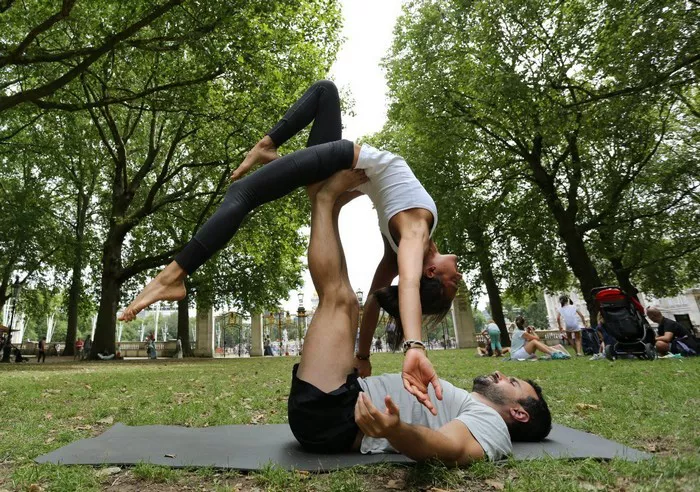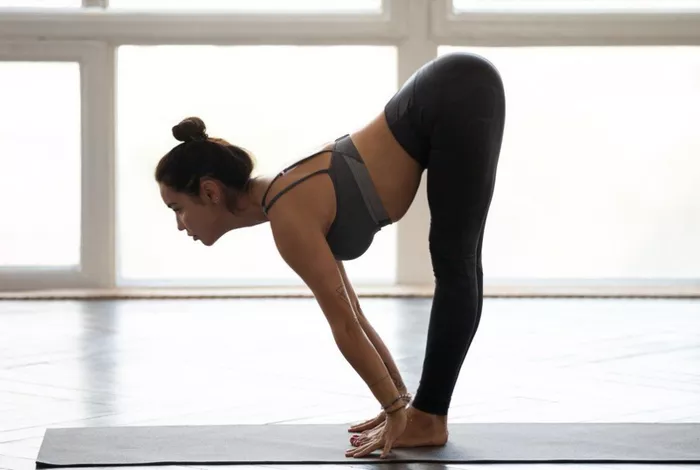Aerial yoga, a unique fusion of traditional yoga practices and acrobatic elements, has gained popularity in recent years for its ability to offer a different perspective on yoga. While standard yoga poses help in building strength, flexibility, and mental clarity, aerial yoga introduces a suspension component using a hammock or silk fabric. The practitioner performs various yoga postures while being partially or fully supported by this hammock.
One of the key benefits that people seek when practicing yoga is relief from back pain. Back issues, especially lower back pain, are among the most common health complaints worldwide, often caused by poor posture, muscle weakness, stress, or injury. But is aerial yoga effective in addressing these issues? In this article, we’ll explore how aerial yoga can impact the health of your back, what the potential benefits and risks are, and who should consider including aerial yoga in their fitness routine.
What Is Aerial Yoga?
Before diving into the specifics of its effects on back health, it’s important to understand what aerial yoga entails. Aerial yoga, also known as anti-gravity yoga, uses a suspended hammock or fabric to support the body during various yoga poses. This hammock is typically hung from the ceiling and allows practitioners to perform inversions, balance poses, stretches, and strengthening exercises that may not be accessible through traditional yoga due to gravity.
The hammock provides support in challenging poses, allowing the practitioner to ease into the posture more comfortably, while also creating the opportunity to challenge the body in new ways. The suspension aspect of the practice helps to reduce the impact on joints, making it a low-impact form of exercise that may benefit people with certain physical limitations.
How Aerial Yoga Benefits the Back
Now, let’s address the core question: Is aerial yoga good for your back? Here are some key ways in which aerial yoga can contribute to back health:
1. Spinal Decompression
One of the standout features of aerial yoga is the ability to perform inverted poses or poses where the body is suspended in the air. This allows gravity to work in the opposite direction, which can provide significant relief for the spine. When you invert your body, the spine gets a much-needed stretch and decompression. The spine naturally compresses during daily activities, especially for individuals who spend long hours sitting. This compression can lead to back pain and discomfort.
In aerial yoga, by using the hammock to support your body while in an inversion, you create space between the vertebrae. This helps to alleviate pressure on the discs and joints of the spine, promoting better spinal health and reducing back pain. The gentle decompression may also improve circulation, further aiding in muscle recovery and the alleviation of tension in the back.
2. Improved Posture
A key element of back pain, especially in modern society, is poor posture. Many people sit for long periods, slouching in chairs, which can contribute to muscle tightness, especially in the lower back and upper back regions. Aerial yoga can help by encouraging better alignment and posture.
During aerial yoga, the hammock supports the body and encourages alignment while in various poses. This sensation of being “held up” while performing stretches and strengthening exercises can teach the body what proper posture feels like, both during practice and in daily activities. With regular practice, aerial yoga can help strengthen the muscles that support the spine and improve posture, reducing the risk of developing chronic back pain.
3. Core Strengthening
The core muscles play a crucial role in supporting the spine. Weak abdominal muscles and lower back muscles can lead to poor posture, misalignment of the spine, and back pain. Aerial yoga requires engaging the core to stabilize the body while performing various poses. As you work to balance in the hammock or perform specific poses like plank variations, the core muscles—especially the abdominals and lower back—are strengthened.
By consistently building core strength, you improve the support structure for your spine, which can alleviate and prevent back pain. A stronger core helps to maintain proper spinal alignment, reducing strain on the back and lowering the risk of injury.
4. Increased Flexibility and Stretching
Tight muscles are another common contributor to back pain. When muscles become stiff, especially in the lower back, it can lead to discomfort and even more serious injuries. Aerial yoga allows for deeper stretches and more fluid movements due to the support of the hammock.
When suspended in the air, gravity helps to pull the body deeper into stretches that may be difficult to achieve on the ground. This increased flexibility in the back and surrounding muscles can help release tension and reduce stiffness, leading to a more mobile spine. Over time, regular aerial yoga practice can help lengthen muscles in the back, improve range of motion, and ease chronic tightness.
5. Stress Relief and Mental Well-being
Back pain is often worsened by stress and tension. In today’s world, chronic stress is a significant factor in both physical and mental health. Aerial yoga can help reduce stress, which in turn may alleviate some of the physical tension held in the back.
The fluidity and mindfulness of aerial yoga promote relaxation and calmness. The focus on breathing, combined with the support of the hammock, creates an opportunity to release mental and physical tension, helping practitioners achieve a sense of well-being. By calming the nervous system, aerial yoga can reduce muscle tightness and improve overall body awareness, which is key to preventing and managing back pain.
6. Rehabilitation for Injuries
For individuals recovering from back injuries, aerial yoga can be an effective rehabilitation tool. The support of the hammock makes it easier to perform certain movements and stretches without putting too much strain on the injured area. By practicing gentle inversions, core strengthening exercises, and stretches, practitioners can rehabilitate their backs more safely.
However, if you have a serious injury, it’s essential to work with a healthcare professional or physical therapist before engaging in aerial yoga. For those with minor or moderate back issues, the practice may offer significant benefits in terms of healing and strengthening the affected areas.
Potential Risks of Aerial Yoga for Your Back
While aerial yoga can provide several benefits for the back, it’s important to be mindful of certain risks, especially for individuals with pre-existing back conditions or those new to the practice.
1. Improper Technique or Overexertion
Aerial yoga requires proper technique to avoid injury. If the hammock is not adjusted correctly or if the practitioner is not using proper alignment, there is a risk of straining the back or neck. Additionally, pushing too hard during inversions or other challenging poses can lead to injury. It’s crucial to practice under the guidance of a certified instructor, especially if you’re a beginner.
2. Not Suitable for Certain Back Conditions
Aerial yoga may not be suitable for everyone, particularly those with severe spinal conditions like herniated discs, spinal stenosis, or other serious back issues. Inversions or certain poses may aggravate the condition, leading to more pain or discomfort. It’s important to consult a healthcare provider before beginning aerial yoga if you have a pre-existing back condition.
3. Balance and Coordination Challenges
For individuals who are not familiar with suspension exercises or who have a lack of balance and coordination, aerial yoga can feel intimidating and challenging. In some cases, it might lead to falls or injuries if the practitioner is not fully comfortable with the movements.
Who Should Consider Aerial Yoga?
Aerial yoga can be a great practice for people looking to improve their back health, particularly for those who:
- Experience mild to moderate back pain
- Want to improve their flexibility and posture
- Are looking to strengthen their core and support spinal health
- Are recovering from minor back injuries (under medical supervision)
- Seek stress relief and mental relaxation
However, if you have more severe back issues such as a herniated disc, spinal stenosis, or osteoporosis, it’s best to consult with a doctor or physical therapist before trying aerial yoga. A qualified instructor can also help tailor the practice to your specific needs and limitations.
Conclusion
Aerial yoga offers a unique and effective approach to improving back health. With its ability to decompress the spine, strengthen the core, increase flexibility, and improve posture, it can be a valuable addition to your fitness routine. The supportive nature of the hammock allows practitioners to explore deeper stretches and more advanced poses, all while minimizing the risk of strain or injury.
As with any form of exercise, it’s important to practice safely and listen to your body. If you’re new to aerial yoga or have specific back issues, it’s recommended to work with a qualified instructor and consult with your healthcare provider to ensure it’s a suitable practice for your needs.
In summary, when practiced correctly, aerial yoga can be a fantastic tool for supporting back health, offering both physical and mental benefits. It’s worth considering if you’re looking for a dynamic way to improve flexibility, strength, and posture, and it could play a key role in relieving or preventing back pain.
Related Topics















